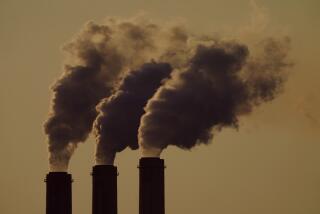U.S. fights EU on airline carbon emissions
On Wednesday, the European Union’s highest court fended off a challenge from the U.S. and established greenhouse gas emissions controls for all airlines flying anywhere in Europe. Airlines now will be required to pay or trade for gas emission allowances, beginning Jan. 1, although the first year is largely free of charge.
Could the U.S. be far behind in creating a similar cap-and-trade system? The EU fight doesn’t make it look good.
“A number of U.S. airlines and then the U.S. airline industry association [now known as Airlines for America] fought it in the European courts, which is why we had this decision [Wednesday],” said Martin Wagner, managing attorney for the International Program at Earthjustice. The group joined a coalition of environmental groups in support of the EU position at the high court in Luxembourg. India and China registered objections to the EU regs.
U.S. Secretary of State Hillary Rodham Clinton and Transportation Secretary Ray LaHood went so far as to issue a letter to the EU on the day before the ruling, threatening “appropriate action.” She did not mean compliance.
“Her letter was of somewhat suspicious timing, in that it came just before the European court was scheduled to issue its decision, and called on Europe not to issue these regulations, and essentially issued a threat of some kind of retaliatory action from the United States,” Wagner said. “Which is at least a suggestion of a lack of respect for Europe’s laws and for its court.”
Airline emissions are now estimated to contribute 3% of global carbon emissions. Half of that comes from U.S. airlines – more than five times more than the next greatest airline emitter. With growth in the airline industry, overall greenhouse gas emissions from airplanes are expected to triple by mid-century.
There are also concerns over airline emissions because they are emitted high in the atmosphere, where they contribute to cloud and contrail formation. Some scientists have estimated that the global warming effects of those emissions are much higher than the CO2 produced, just because of their altitude.
Even with millions of cars and trucks on the roads in the U.S., airlines account for 12% of transportation emissions nationwide.
“We have petitioned the U.S. EPA, calling on [it] to regulate greenhouse gas pollution from aircraft, and we’re currently having to sue them to respond to that petition because they haven’t yet,” Wagner added.
The airlines and regulators now face the sticky task of leveling the economic playing field through a global regulatory system for airlines emissions. We won’t see this anytime soon.
RELATED:
EU high court to rule on airline pollution charges
EPA issues strong limits on mercury emissions from smokestacks
Breakthrough could double solar energy output
-- Dean Kuipers






